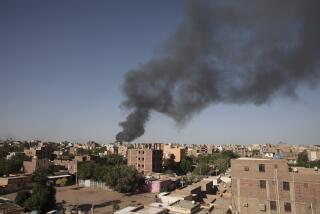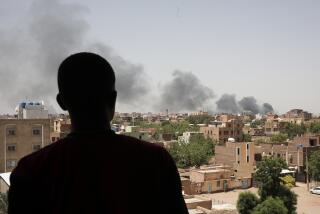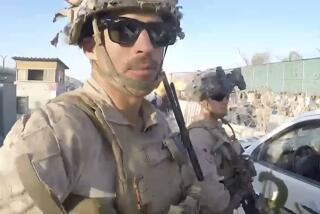U.S. Teams Arrive in Nairobi; Blast Victims Mourned
- Share via
NAIROBI, Kenya — A phalanx of American medical, military, intelligence and diplomatic personnel descended on this capital Sunday as U.S. Ambassador Prudence Bushnell held a solemn memorial service at her suburban Nairobi residence for a dozen dead Americans.
The number of Americans known to have been killed in Friday’s bombing at the U.S. Embassy in Nairobi rose to 12 as officials identified the remains of the last American employee at the embassy unaccounted for--Consul General Julian Bartley, 55, whose 20-year-old son, Jay, also was killed.
More than 300 Americans, with truckloads of equipment in tow, set up a command center in a red-brick building across town from the blast site to lead the main leg of twin probes into the apparently synchronized explosions in Nairobi and Dar es Salaam, capital of neighboring Tanzania.
Dozens of U.S. investigators sifted through a mountain of debris in the gutted embassy building as armed Marines kept everyone at bay--including Kenyan authorities--in an attempt to preserve evidence at the scene.
Church bells pealed across Kenya as services were held in memory of the 190 people known to have been killed in the terrorist attack here. More than 4,000 were reported injured. Kenyan President Daniel Arap Moi, visiting the site, said for the first time that investigators “are pursuing several clues,” although he refused to elaborate.
In Tanzania, there were reports that U.S. officials might have video footage of the bombers who struck the U.S. Embassy there, where at least 10 people were killed, none of them American.
A security camera atop the embassy, pointing toward the guardhouse and the compound’s main gate, might have recorded the attack, according to the reports, which quoted a U.S. diplomat in Dar es Salaam. But in Washington, U.S. officials expressed doubt that the camera captured any evidence, because, like many other security cameras, it is believed to have been for monitoring, not recording.
The Clinton administration’s top national security team warned Sunday that the intensive investigations into the near-simultaneous embassy bombings are likely to be long and difficult.
Evaluating each piece of evidence and then trying to piece them together can “take years in some cases,” Defense Secretary William S. Cohen said.
But Clinton’s team pledged that those responsible will be found. “The memory of the United States is very long, and our reach is very far,” Secretary of State Madeleine Albright said on NBC-TV’s “Meet the Press.”
Since 1993, about 40 terrorists have been successfully apprehended abroad, Cohen said.
A Siege Attitude
In Nairobi, U.S. government and military personnel have adopted the posture and attitude of a nation under siege. American soldiers, brandishing rifles, stacked sandbags at the end of the road leading to the new U.S. command center.
Only authorized visitors, bearing official embassy badges or press passes, were allowed in the vicinity of the compound--normally the base for the U.S. Agency for International Development.
Chris Scharf, press officer for the U.S. Embassy, said that at least eight planes carrying scores of Marines, medical evacuation experts, search and rescue specialists, military personnel, State Department officials and FBI agents had arrived in the capital since Friday. A “mortuary” plane, to transport the dead back home, also had arrived, Scharf said.
Officially, U.S. investigators from the FBI, CIA, Pentagon and State Department are still at an early stage of not ruling out any possibilities. “No list of suspects has been drawn up,” Cohen said on ABC-TV’s “This Week.” “We are looking at all possibilities, and nothing has been included or excluded.”
The Defense Department boss warned against rushing to “piece together a portrait” of the terrorists involved based on “fragments” of information. But in private, administration officials conceded that they are looking closely at Saudi dissident Osama bin Laden, who now lives in Kandahar, Afghanistan.
Bin Laden has at various times worked out of Sudan, which is close to both East African countries, and Sudan’s government is headed by a radical Islamic movement.
Senior officials also said that they do not believe Bin Laden ever intended to honor a deal said to have been negotiated by Saudi Crown Prince Abdullah with the militant Islamic Taliban government in the Afghan capital, Kabul.
Reportedly, the deal would, in essence, prohibit Bin Laden from engaging in political activities or foreign misadventures. In exchange, he and his coterie of followers would be allowed to remain in Afghanistan.
“Even the Taliban has begun to tire of Bin Laden,” said a senior administration official.
Skepticism Over Claim
A weekend claim of responsibility for the Friday blasts by an unknown group called the Islamic Army for the Liberation of Holy Places, which telephoned a media outlet in the Persian Gulf, is among several leads being pursued.
But privately, U.S. officials voiced skepticism about that claim. Only a small number of movements or countries have both a motive and sufficiently advanced capability to have coordinated the two blasts, counter-terrorism officials said.
“It was not the act of some isolated individual, a madman. . . . It was probably some organized effort long in the planning,” Cohen said.
Israeli rescue workers assisted by Kenyan volunteers and military personnel continued to use cranes, drills and blowtorches in a painstaking effort to untangle heaps of mangled steel, plaster, bricks and concrete.
The rescuers indicated that they had lost oral contact with the last known survivor in the collapsed Ufundi Cooperative office building--next to the U.S. Embassy--which bore the brunt of the blast. The woman, known as Rose, had stopped talking and was feared dead.
“The death toll among Kenyans, we expect to rise,” said Scharf. “This has been one of the most difficult tasks--to locate our Kenyan employees, many of whom have died.”
About 100 Kenyan employees of the embassy remained unaccounted for, Scharf said.
Julian Bartley, the last American victim found, was a senior embassy official who had spent 24 years in the Foreign Service, with assignments in the Dominican Republic, Colombia, Spain, Israel and South Korea before his final posting to Kenya. His son, Jay, was a student at the United States International University in Nairobi who was spending the summer at the embassy as an intern.
Fortune did shine on Grace Akinyi and her 13-year-old son, Gabriel Wasonga. They were discovered Sunday atop the 21-story Cooperative Bank House skyscraper--adjacent to the Ufundi office building--where the U.S. ambassador had also been when the bomb exploded. All attention had been focused on the devastated U.S. Embassy and Ufundi buildings.
Strange sounds emanating from the high-rise as darkness engulfed the city late Saturday apparently had spooked some of the local volunteer rescue workers. Some of the noises were described as faint echoes. And Akinyi and her son were said to be too afraid to move.
The next morning, rescuers started to pick through the rubble on each floor of the bank building. “There is hope that there are still some people alive,” said Al Panico, head of the regional delegation for the Nairobi-based International Federation of Red Cross and Red Crescent Societies. “There are still some air pockets in there. . . We just have to keep digging.”
But volunteer rescue worker Jackson Muthomi, who had slept only one hour since arriving at the bomb site Friday, said he was quitting because he was so overwhelmed.
“I have to stop now,” said Muthomi, an engineer. “I was digging in the Ufundi building. I lifted a slab of concrete to find a head beneath it. I started to uncover the rest of the body. But after I reached the hip, the body just stopped. I’ve seen enough.”
Scores of injured were still being treated at several Nairobi hospitals. Dozens of others had been discharged or taken off the critical list, doctors said. U.S. medical teams also evacuated 10 Americans and five Kenyans working in the embassy to Germany, a U.S. official said, adding that the evacuees would most likely end up in the States.
Bewilderment
“All I can say is just for God to forgive [those who planted the bomb],” said the hospitalized James Chege Babu, 39, an accountant for the Ministry of Trade, who was on the sixth floor of Cooperative House and sustained severe, disfiguring facial and bodily injuries from flying glass and debris. “Maybe it was a political motive. But we have nothing to do with politics, so they hurt the wrong people.”
The Kenyan president echoed this sentiment during his tour of the bomb site earlier in the day, saying that he did not believe the bombing would aid anyone’s cause.
“How can they expect Kenyans to support their cause?” asked an obviously bereaved Moi. “How can they expect us to support their cause if they use such methods?”
*
Simmons reported from Nairobi and Wright from Washington. Times staff writer Marc Lacey in Washington also contributed to this report.
More to Read
Sign up for Essential California
The most important California stories and recommendations in your inbox every morning.
You may occasionally receive promotional content from the Los Angeles Times.














